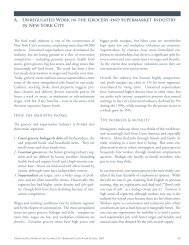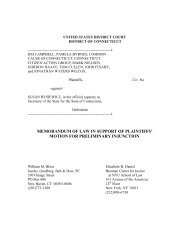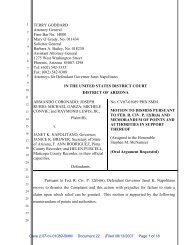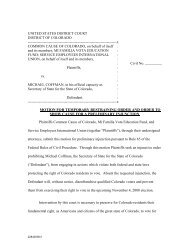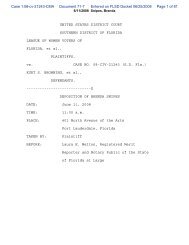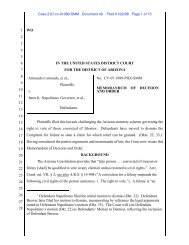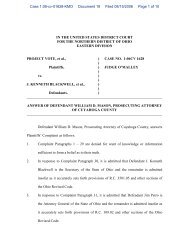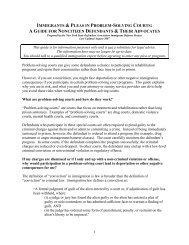going to start writing letters for a $200 item, I’mout of business.”Alysa Cardone described a similar dilemma inteaching. “I teach Web design, both on the highschool and college level. I get a lot of projectsthat are what I would call fan sites. One of mygroups right now is doing an animé site. Howcan they put together a Web site without usingsomebody else’s images? It’s all about animé.These are the issues that, as a teacher, I get veryconfused about. I got really worried, because theyounger they are, the less they understand aboutstealing from the Web.”“...sometimes, in the causeof educating people whohave no money, I do copymaterial.”Cardone surfed the Web for guidance. “Istarted searching in Google, and I found aconsortium on digital rights at the University ofTexas Web site. 128 I took what I thought wouldwork for them, that they could understand.I condensed it, and put it at the end of mysyllabus. I made them read it out loud the firstday of class.“And of course, as the semester goes on, Ihave an animé site. I have an e-commerce sitethat’s using brand images, because how do youteach e-commerce marketing without them?They can’t invent new products. I mean, weonly have 15 weeks. So I bent the guidelinesa little, but it’s staying in the classroom rightnow.“But my school is going to put up some ofthese on their Web site, to entice people intoour new Web design program. And I’m reallyconfused because what if they put up this greatsite, and it’s all re-purposed content that theyhad no permission to use? Is my school going tobe liable for this?“Another big area of concern is grants. I’ma recipient of a grant, and we’re photographingand creating an oral history for this communityin the Bronx, Mott Haven. The legal counsel atmy school is way more concerned about humansubject survey information and photo releases.But I have to make an online gallery out of this.What happens when I put all these pictures on theWeb, and anybody can download them? That’sa concern because I’m having these people thatI’m photographing sign all these documents, andI have no control once I put that stuff up, whathappens to it. We could invest in watermarkingtechnology, but we have no extra money.”Cardone also talked about classroom use.“I do photocopy tutorials and use them in myclasses. At one point, I only used stuff that wasavailable in the public library, so that they couldgo and research the book themselves. But thenI stopped doing that, because when I’m dealingwith new releases of software, they’re not in thelibrary yet. And I need the latest tutorials. I can’tforce them to buy all these books. They haveno money. I teach in the South Bronx. Theydon’t even have cameras when they take myphotography class. So sometimes, in the causeof educating people who have no money, I docopy material.”She doesn’t think that such copying wouldqualify as fair use, because “my photocopycenter won’t do it out of the book. I have tomake a flat copy on paper because they think it’san infringement if they copy out of the book. SoI know that it’s probably not fair use, but in theinterest of education – and I’m not making anymoney; I’m just trying to help them.” 129Does she hold students strictly to the guidelines?“Well, I started to think about that, becauseI really like their site, and I want to put it up asan example of what you can do as a class. Theytook a Twinkie, for example, and they outlinedit, and put the little animé character sitting on aTwinkie. Twinkie’s a registered trademark. But ifyou look on the Web, fan sites are like that. Thisis a very typical fan site and this is the kind ofthing that my students want to create. And inmy opinion, the more interested they are in thesubject matter, the more they’re going to engagein it, and the more they’re going to learn.”24 Will Fair Use Survive?
Talbot commented: “Here’s the headline:Hostess sues penniless Bronx student.”Another participant exclaimed: “Well, it’sparody. I mean, really!”Cardone added: “Where we work influenceshow we deal with this. When I worked inprivate publishing, it was totally not appropriateever to use an image in the wrong way. Ineducation, it’s a little different. You don’t wantto give people the idea that it’s okay to traceand collage for money. But if I’m not makingmoney, then it’s probably okay as long as I citeor I use things appropriately. I don’t know.How does everybody else feel about this?”From the other side of the copyright divide,Barbara Levy described seeing images verysimilar to ones she had created, of a sunriseover Great South Bay in Long Island. “And Iwas shocked – I thought, did he just move thecamera a little bit to the left, a little to the right,did he crop my thing and move the yellowsomewhere else? There were six or seven imagesthat were almost identical to six or seven imagesof mine. My immediate response was, oh I’mparanoid. Two people can have the same ideaat the same time. But I didn’t like it.”Eric Gray responded: “If somebody was touse my image and credit me, I’d be like, ‘Thankyou. No problem.’ If they were to not creditme, then I’d start having a big problem becauseI would like to be recognized for it. But inphotography, it’s hard to find a truly uniqueimage. Your example, I’ve seen that imageabout a hundred times, I’m sorry to say. Thesun and the ocean, it is a universal thing.”What about documentary photography,which might include billboards or other objectsthat display trademarked logos as part of thescene? Gray thought that “if it’s in the publicforum, it’s fair to have a picture taken of it” – atleast, as long as it is not the main subject of thephoto. Cardone gave an example: “My studenttook a picture of the building on 42nd Streetwith all the clocks and different time zones, andan MTA bus going past it, blurry, and therewas an ad on the side of the bus that said, ‘Thefirst time.’ It was a really profound picture. Ithad the speed of the traffic, the ad with thatstatement, and then this building which is veryrecognizable. But if she wanted to exhibit that,I don’t know how easy that would be. It is not apicture of the ad. It’s a statement about time inthe city.”Sandra Camomile said: “I also teachstudents in a digital world, and I feel I have aresponsibility to give them information on howto protect themselves, and possibly companiesthat they are going to work for. So this is whatI tell them. If they’re going to take images fromthe Internet and use somebody else’s work, theyhave to manipulate the image enough that theartist will not be able to recognize that imageas their own. I have them show me the original,and I look at what they’ve done. And there haveto be significant changes before I would say,‘yeah I think you’d be okay.’ I don’t know thisfor certain, though.“I’ve heard percentages, like it needs to bechanged 75%. I’ve heard 80%, 90%, 95%. I’velooked for information. It seems to be a movingtarget. So I give them the advice that if the artistcan’t recognize the work, then you’re going to beokay. Otherwise, you could put your companyinto bankruptcy. You could put yourself intobankruptcy with legal fees. And I tell them thatright now copyright and fair use are uncertain.And you don’t want to become the test case.” 130Tony White has also been educatinghimself about copyright law, “but what I finddiscouraging is, the more you learn aboutcopyright and fair use, the more of a chillingeffect it has on your creative expression. Greatereducation about this topic, for artists, seems tohave a chilling effect.”The meeting ended with a word of cautionfrom Eve Sinaiko, publications director ofthe College Art Association: “I heard aroundthis table a fair amount of misinformation– not that anyone did this deliberately. But becareful about asking each other for advice onpoints of law.“From CAA’s point of view, we are aware thatfor both artists who create art and scholars whowrite about it and study it, there are enormoustensions and increasing difficulties in thisrealm. Misunderstandings of the law, fear ofthe law, excessively aggressive uses of the law,or reluctance to assert the law on both sides areBrennan Center for Justice 25
- Page 1 and 2: WILLFAIR USESURVIVE?Free Expression
- Page 3 and 4: WILLFAIR USESURVIVE?Free Expression
- Page 5: ContentsExecutive Summary . . . . .
- Page 9 and 10: unhappy years of World War II.” 1
- Page 11 and 12: Although §512 does allow an ISP
- Page 13 and 14: music, distance learning, interlibr
- Page 15 and 16: CHAPTER 1The Legal LandscapeThis ch
- Page 17 and 18: Court’s “Oh, Pretty Woman” de
- Page 19 and 20: the public would be confused about
- Page 21 and 22: CHAPTER 2Quoting Sartre, Using Prok
- Page 23 and 24: owned by Gallimard [the French publ
- Page 26 and 27: well, this and this person gave it
- Page 28 and 29: you can do with the pages of Time a
- Page 32 and 33: causing problems for our communitie
- Page 34 and 35: or Not’ people. So we took it dow
- Page 36 and 37: The American Pool Players Associati
- Page 38 and 39: “Paris Hilton Sex Tape” 150 (ho
- Page 40 and 41: howardhallis.com,” a comedy and c
- Page 42 and 43: legitimate borrowing of protected m
- Page 44 and 45: Dan Hamilton, managing editor of th
- Page 46 and 47: legal action as long as eInfoworld
- Page 48 and 49: At that point, Cox took to the blog
- Page 50 and 51: her books, but not created by Anne
- Page 52 and 53: CHAPTER 5Internet Infidels and Home
- Page 54 and 55: she attributed to the many form let
- Page 56 and 57: “Without his permission, the gove
- Page 58 and 59: eproducing an artwork in a book wit
- Page 60 and 61: ConclusionWhat can we learn from th
- Page 62 and 63: Reiff thought that instead, the gov
- Page 64 and 65: Endnotes1 Mattel v. Walking Mountai
- Page 66 and 67: 48 See Katie Dean, “Eyes on the P
- Page 68 and 69: 109 Not an exact quote. See Alan Al
- Page 70 and 71: 149 http://msophelia.blogspot.com/p
- Page 72 and 73: 215 “MBA Legal Defense Initiative
- Page 74 and 75: lank left hand page
- Page 76: 161 Avenue of the Americas12 th Flo



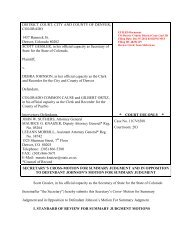
![Download the Letter [PDF] - Brennan Center for Justice](https://img.yumpu.com/50139248/1/190x245/download-the-letter-pdf-brennan-center-for-justice.jpg?quality=85)
